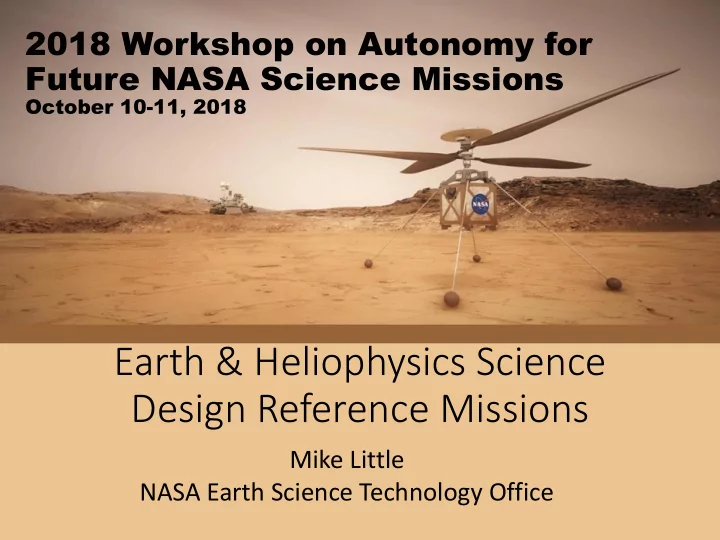

2018 Workshop on Autonomy for Future NASA Science Missions October 10-11, 2018 Earth & Heliophysics Science Design Reference Missions Mike Little NASA Earth Science Technology Office
Earth and Helio Science DRM Team Name Name Marge Cole Mike Seablom Mike Little Mahta Moghaddam Jacqueline LeMoigne-Stewart Graeme Smith Matthew Tarascio Lena Braatz Joel Johson Catherine Pavlov Philip Koopman Mark Cheung James Donlon Andrew Sabelhaus Eric Frew Steve Chien Lisa Callahan Steve Kepko Martyn Clark Tom Wagner Sujay Kumar Barry Lefer Gerald Bawden Jared Entin
Earth and Helio Science Reference Missions ID Name Description ES-1 Demand-driven A multi-vantage point (in situ, airborne, satellite platforms) observing system responds to requests for observations from multiple research projects, instrument (line 8) Observing science teams, cal-val encounters. ES-2 Model-driven Observing As forecast skill degrades, an operational model requests specific observations (parameters, locations, range, timing), selecting from all available sensors and (line 9) (Operational) instruments (in situ, airborne and remote sensing from space). ES-3 Phased Array A constellation of satellites creates a phased array. Increasing the amount of observed signal for a specific event, the nodes need station keeping and the beam- (line 10) forming requires coordination among nodes. ES-4 String of Observations Sequential Observations of selected phenomenon/ event. A string of steerable instruments in a satellite train lengthens the remote sensing observation of (line 11) transient or transitional phenomena (such as hurricane rapid intensification or the life span of a tornado). ES-5 Intelligent Observation Intelligent Observation Strategies or Autonomous optimization of measurement acquisition. Combine onboard data processing, real-time access to other (line 12) Strategies (Research) spacecraft, in-situ data and ground prediction data, and autonomous planning and scheduling of observations. HS-1 React to Space Weather Interconnected sensors throughout the heliosphere improve forecast quality and alerts to space weather events. Ground networks on other planets (e.g. radiation (line 15) Events sensors on mars), instruments on human spacecraft (both commercial and NASA), all autonomously connected to predictive capabilities. System can autonomously decide to launch 'spacecraft on demand,’ then rapidly commission and pull data from spacecraft on line, assimilate into space weather predictive models. Autonomous monitoring of solar active regions, coupled with models of solar eruptive events, to provide lead time.
Recommend
More recommend